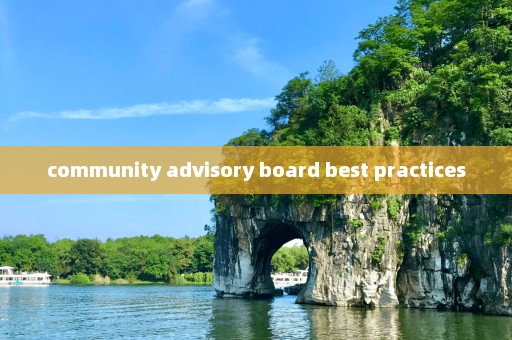It's a cool autumn morning, and I find myself surrounded by the bustling energy of a community advisory board meeting. The room is filled with passionate individuals from diverse backgrounds, all united by a common goal: to make a positive impact in our community. As a specialist in this field, I've witnessed firsthand the power of a well-functioning advisory board. In this blog post, I'll share my insights and best practices to help your community advisory board thrive.

Establishing a Strong Foundation
A successful community advisory board starts with a solid foundation. Here are some key steps to set the stage for success:
a. Define the Board's Purpose
Clarity is crucial when establishing an advisory board. Clearly define the board's purpose, goals, and objectives. This will guide the selection of board members and ensure that everyone is aligned and working towards a common vision.
b. Recruit Diverse and Engaged Members
A diverse board brings a variety of perspectives, ideas, and experiences to the table. When recruiting members, seek individuals from different backgrounds, professions, and demographics. Additionally, look for individuals who are passionate about the community's well-being and willing to actively contribute their time and expertise.
c. Develop Clear Bylaws and Policies
Bylaws and policies provide a framework for the board's operations. They outline roles, responsibilities, meeting schedules, and decision-making processes. Ensure that these documents are easily accessible and regularly reviewed and updated as needed.
Effective Meetings and Communication
Meetings are the lifeblood of an advisory board. Here's how to make the most of your time together:
a. Prepare a Structured Agenda
Send out a detailed agenda prior to each meeting, allowing members to come prepared and focused. Include specific topics, discussion points, and any necessary background materials. This will help facilitate a productive and efficient meeting.
b. Encourage Open Dialogue and Active Participation
Foster an environment where all board members feel comfortable expressing their opinions and engaging in constructive dialogue. Encourage participation by assigning roles, such as discussion leaders or note-takers, and ensure that everyone has an opportunity to contribute.
c. Leverage Technology for Communication
Utilize email, project management tools, and virtual meeting platforms to enhance communication between meetings. This will keep everyone informed, engaged, and connected.
Leveraging Data and Metrics
Data-driven decision-making is essential for an effective advisory board. Here's how to incorporate data into your processes:
a. Identify Key Performance Indicators (KPIs)
Establish relevant KPIs that align with the board's goals. These metrics will help track progress, identify areas for improvement, and measure the impact of initiatives.
b. Regularly Review and Analyze Data
Schedule regular data review sessions to monitor KPIs and analyze trends. This will provide valuable insights and inform strategic decision-making.
c. Share Data with Board Members
Transparency is key. Regularly share data and reports with board members to keep them informed and engaged. This will also facilitate discussions and enable members to make well-informed decisions.
Community Engagement and Collaboration
Community advisory boards thrive when they actively engage with the community and collaborate with stakeholders. Consider the following practices:
a. Conduct Regular Community Needs Assessments
Stay connected with the community's needs and priorities by conducting regular assessments. This will ensure that your initiatives address the most pressing issues and concerns.
b. Foster Collaborative Relationships
Build strong relationships with local organizations, government agencies, and other stakeholders. Collaboration can amplify your impact and provide access to additional resources and expertise.
c. Encourage Community Participation
Increase community involvement by hosting public meetings, workshops, and events. This will provide opportunities for residents to voice their opinions, contribute ideas, and become active participants in the advisory board's initiatives.
Conclusion
As I reflect on my experiences working with community advisory boards, I am reminded of the immense potential they hold for driving positive change. By following these best practices, your board can create a lasting impact in your community. Remember, the key to success lies in establishing a strong foundation, maintaining effective communication, leveraging data, and engaging with the community. Embrace these principles, and watch your advisory board thrive.
Post a comment

Comment List